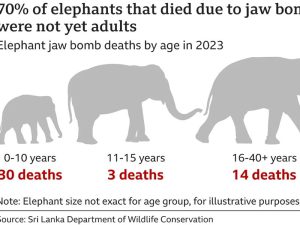Sumitra Malkandi is haunted by the tragic evening in March last year when her husband, Thilak Kumara, fell victim to a fatal elephant encounter near their home in a central Sri Lankan farming village. While she was engrossed in kitchen activities, Thilak Kumara was tending to their cows just outside. The tranquility shattered when an elephant’s trumpeting roar echoed, leading to a tragic event that left Sumitra Malkandi, a 45-year-old mother of three, shattered. The elephant retreated after the horrified cries of villagers, but the scars of the incident persisted, casting a shadow over the family.
Thalgaswewa, their village in the Kurunegala district, now grapples with an escalating conflict between humans and elephants. Over the past two years, local officials have reported three human fatalities and the loss of ten elephants in Thalgaswewa and neighboring villages. The encroachment of farming into elephant habitats, rich in coconut, mango, and banana trees—preferred by elephants—has intensified the struggle for coexistence.
Survival is becoming increasingly precarious.
The broader picture reveals a grim reality for both humans and elephants across Sri Lanka. In 2023, 176 people lost their lives in human-elephant encounters, while 470 elephants succumbed—half of them due to human activities, the rest to illness or accidents. The clash between expanding agricultural lands and elephant habitats disrupts the giants’ food and water sources, making their survival increasingly precarious.
Post the civil war in 2009, the government released previously restricted lands, paving the way for increased farming and settlements. Sri Lanka’s elephant expert, Prithiviraj Fernando, points out that the crops cultivated are highly appealing to elephants, exacerbating the conflict. Conservationists urge immediate government intervention to address the escalating casualties, emphasizing the need for sustainable solutions like cultivating crops that don’t attract elephants.
Despite legal protections and cultural reverence for elephants in Sri Lanka, farmers resort to lethal measures, including illegal electric fences with fatal voltages, poison, explosive “jaw bombs,” and even shooting at elephants. The government’s plan to expand the use of electric fencing is underway, but activists stress the importance of humane alternatives.
Sri Lanka’s protected habitats host around 5,800 elephants, facing challenges from shrinking habitats, droughts, and human interactions. The urgency to address the human-elephant conflict has gained momentum, driven by a record number of elephant deaths in 2023. Prithiviraj Fernando warns that if the current trend continues, up to 70% of Sri Lanka’s elephants could vanish, with the added concern of a disproportionate number of male elephants succumbing to the conflict, jeopardizing the species’ survival. As the nation grapples with an economic crisis, addressing the human-elephant conflict becomes imperative to ensure harmonious coexistence and the preservation of Sri Lanka’s iconic elephants.








